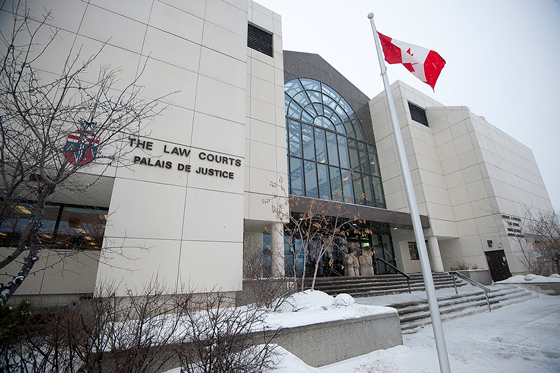
Photo by Whitehorse Star
EVIDENCE CHALLENGED – Day two of Michael Gaber's trial gave a glimpse into the defence's case as they challenged the analysis of pills seized on the former correctional officer.

Photo by Whitehorse Star
EVIDENCE CHALLENGED – Day two of Michael Gaber's trial gave a glimpse into the defence's case as they challenged the analysis of pills seized on the former correctional officer.
The defence’s case in the trial of former correctional officer Michael Gaber became clearer on Thursday as they relentlessly challenged drug analysis evidence.
The defence’s case in the trial of former correctional officer Michael Gaber became clearer on Thursday as they relentlessly challenged drug analysis evidence.
The court heard from Health Canada drug analyst Sarita Jaswal in a very detailed testimony about the drug analysis process and the results of the analysis done on one of the pills Gaber had when he was arrested.
Gaber, 47, was charged with two counts of possessing drugs for the purpose of trafficking on Dec. 26, 2013.
Jaswal, a witness called by Crown prosecutor Eric Marcoux, was declared an expert witness by Yukon Supreme Court Justice Ron Veale.
She’s been working at the Health Canada drug analysis lab of Vancouver for the past 28 years, and assists police in identifying clandestine drug labs.
Jaswal told the court she had analyzed more than 20,000 exhibits in her career and testified more than 40 times in court.
Jaswal testified she crushed one of the 10 pills the RCMP mailed to her in January 2014.
She then took two sub-samples of the crushed pill that she ran through four different tests.
To analyze substances, she ran the powder through a machine that first vaporized it into a gas. The different compounds then go through a column, before reaching a detector.
The column is coated with a substance that reacts with the different compounds, which in turns means they reach the detector at different times.
Each compound reaches the detector with a different time, which allows to identify them.
Once that test was done, Jaswal compared the results with a reference standard.
The lab uses references – drugs and controlled substances they acquired and tested on their own equipment – to identify the drugs they have.
Once Jaswal ran the pill through the different test, she compared the results with the reference.
These references themselves are verified every two years, she said.
In this case, the Ritalin used as a reference was acquired by the lab in 2004, she told the court.
Defence lawyer David Tarnow grilled Jaswal in cross-interrogation, spending considerable time on the fact Jaswal eyeballed the substance seized and the reference to declare it a match.
Jaswal first said it wasn’t a requirement, but later added she did use a database but didn’t include the results in the report.
In any event, she said she had a “high degree of confidence” the substance tested was Ritalin.
Tarnow went on to argue she was withholding evidence. He also challenged the accuracy of her analysis.
She didn’t tell the defence that the Health Canada Drug Analysis Service, DAS, was certified under the worldwide ISO standard, he said.
He asked Jaswal about the sampling process – when the officer chose 10 out of the 59 pills to send the lab.
“We don’t sample – the police samples,” she said, adding that the only thing her certificate of analyst says is that the one pill she tested contained Ritalin.
Tarnow zeroed in on the RCMP’s handling of the pills.
On Wednesday, RCMP Const. Daniel Bray testified he didn’t clean a table he used to bag the pills seized, and couldn’t say for certain he was wearing gloves.
“That’s not the way we would request police to handle it,” Jaswal said.
However, the pills could only have been contaminated by Ritalin on the table if it was there in a powder form.
That’s because medications like Ritalin are mostly made of inactive filling designed for the active substance to be released once it reached the patient’s gut.
Jaswal also responded to criticisms a defence expert made before the trial and sent to her.
Jaswal rejected the criticisms, saying the expert failed to understand the procedures Health Canada was following, and even sometimes the nomenclature in her report.
The 59 white pills are the only physical evidence put forward in the trial since Veale excluded marijuana seized in Gaber’s car that day.
The search was illegal, Veale ruled last summer.
On Wednesday, the court heard a taped interrogation in which Gaber tells an RCMP constable he needed money and started smuggling packages in.
The trial continued today with the testimony of Suzanne Perry, a former UBC lab analyst, and now a consultant.
She is testifying as an expert witness for the defence.
In order to encourage thoughtful and responsible discussion, website comments will not be visible until a moderator approves them. Please add comments judiciously and refrain from maligning any individual or institution. Read about our user comment and privacy policies.
Your name and email address are required before your comment is posted. Otherwise, your comment will not be posted.
Comments (2)
Up 40 Down 2
moose101 on Feb 1, 2016 at 2:46 pm
For you people that do not Know what Ritalin is . It is a old school drug been around for years it's common name is SPEED addictive and can sometimes kill you.
He had 59 pills. Where did he get them? And he is selling them to our inmates? No wonder they re-offend the minute or within hours after their release . Thanks Mr. Tarnow for defending an innocent drug trafficker .
Up 24 Down 2
Just Say'in on Feb 1, 2016 at 2:42 pm
This is ridiculous. Whatever happened to reasonable doubt? It seems now the criminal is more believed then the lab. What is the world coming to? You wonder why the cops don't want to prosecute.